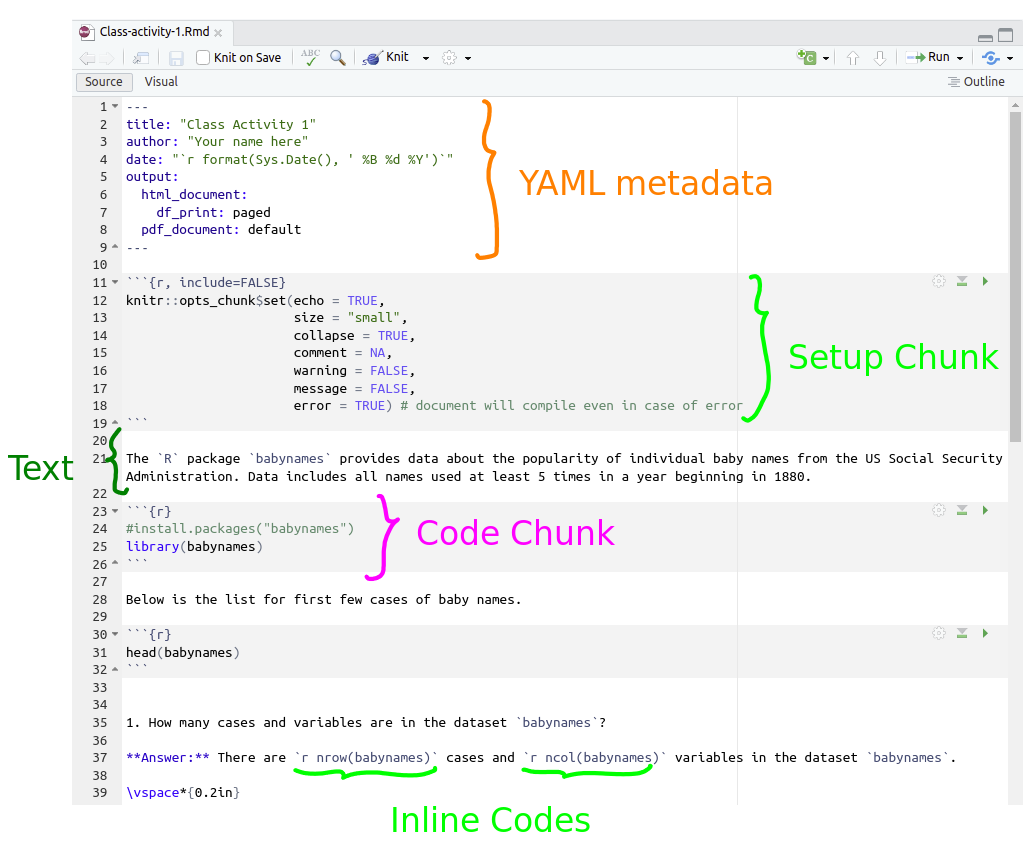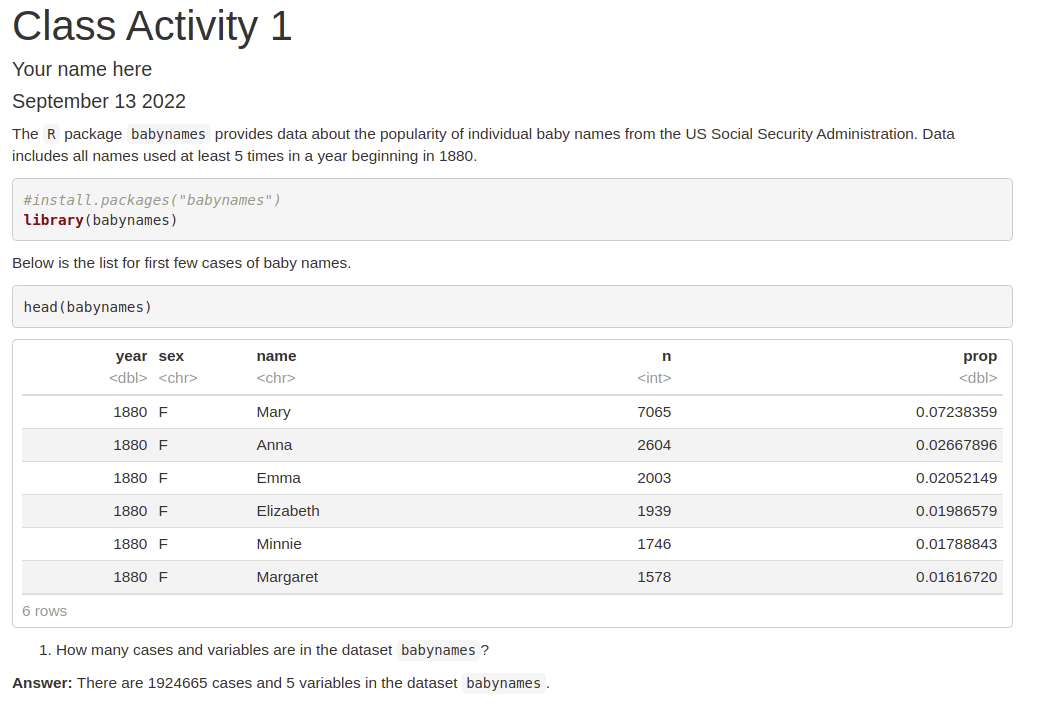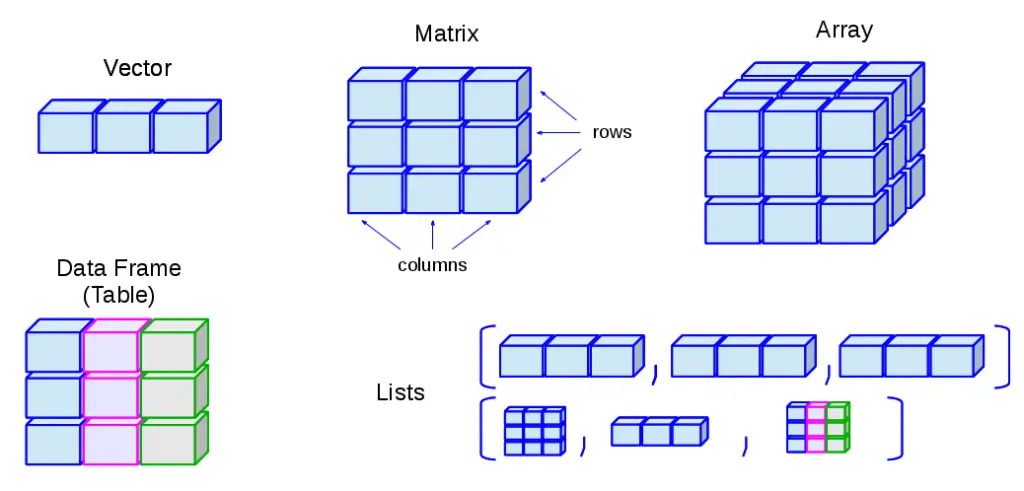
R and R Markdown Basics
STAT 220
Bastola
Reproducible data science
What Does Reproducibility Mean in Data Science?
Short-term goals
- Are the tables and figures reproducible from the code and data?
- Does the code work as intended?
- In addition to what was done, is it clear why it was done? (e.g., how were parameter settings chosen?)
Reproducible data science
What Does Reproducibility Mean in Data Science?
Long-term goals
- Can the code be used for other data?
- Can you extend the code to do other things?
Toolkit for reproducibility
- Scriptability → R
- Literate programming (code, narrative, output in one place) → Posit
- Version control → Git / GitHub
Tour: R Markdown (.Rmd content)

Tour: R Markdown (Rendered html)

Text
Simple rules for:
- section headers (
#,##,etc) - lists (need ~2 tabs to create sublists)
- formatting (bold
**, italics*) - tables
- R syntax (use backward tick `)
- web links
[linked text](url) - latex math equations \(\beta_1 + \beta_2\)
For further help, look at R Markdown Cheatsheet
Code chunks, defined by three backticks
Adding chunks
Add chunks with button or:
- Command (or Cmd)
⌘+ Option (or Alt)⌥+i(Mac) - Ctrl + Alt +
i(Windows/Linux)
Running chunks
Run chunks by:
- Run current chunk button (interactive)
- Knit button / run all chunks
Inline code
How many babies were born with name ‘Aimee’?
`r filtered_names %>% summarise(total = sum(n))`
There are a total of 53476 babies.
In what year were there highest proportion of babies born with the name Aimee?
`r filtered_names %>% filter(prop == max(prop)) %>% pull(year)`
Aimee name was the most popular in 1973.
Chunk labels
```{r peek, echo = FALSE, results = "hide"}
glimpse(filtered_names)
```- Include the chunk label immediately after the language identifier within curly braces, –>
{r label}- Warning: Do not duplicate chunk labels
- Configure options after label separated by commas e.g –>
echo = FALSE
```{r peek, echo = TRUE, results = "show"}
glimpse(filtered_names)
```Rows: 150
Columns: 5
$ year <dbl> 1880, 1881, 1882, 1883, 1884, 1885, 1886, 1887, 1888, 1889, 1890,…
$ sex <chr> "F", "F", "F", "F", "F", "F", "F", "F", "F", "F", "F", "F", "F", …
$ name <chr> "Aimee", "Aimee", "Aimee", "Aimee", "Aimee", "Aimee", "Aimee", "A…
$ n <int> 13, 11, 13, 11, 15, 17, 17, 18, 12, 16, 18, 14, 15, 17, 13, 13, 2…
$ prop <dbl> 0.00013319, 0.00011127, 0.00011236, 0.00009162, 0.00010902, 0.000…Chunk options: : echo and eval
```{r echo = TRUE, eval = TRUE}
glimpse(filtered_names)
```Rows: 150
Columns: 5
$ year <dbl> 1880, 1881, 1882, 1883, 1884, 1885, 1886, 1887, 1888, 1889, 1890,…
$ sex <chr> "F", "F", "F", "F", "F", "F", "F", "F", "F", "F", "F", "F", "F", …
$ name <chr> "Aimee", "Aimee", "Aimee", "Aimee", "Aimee", "Aimee", "Aimee", "A…
$ n <int> 13, 11, 13, 11, 15, 17, 17, 18, 12, 16, 18, 14, 15, 17, 13, 13, 2…
$ prop <dbl> 0.00013319, 0.00011127, 0.00011236, 0.00009162, 0.00010902, 0.000…Saving images using chunk options
```{r plot1, fig.path="img/"}
library(babynames)
your_name <- "Dee"
your_name_data <- babynames %>% filter(name == your_name)
ggplot(data=your_name_data, aes(x=year, y=prop)) +
geom_point(size = 3, alpha = 0.6) +
geom_line(aes(colour = sex), size = 1) +
scale_color_brewer(palette = "Set1") +
labs( x = 'Year',
y = stringr::str_c('Prop. of Babies Named ', your_name),
title = stringr::str_c('Trends in Names: ', your_name))
```
Loading saved images

Summary
| Chunk Option | Outcome |
|---|---|
echo = FALSE |
The code is not included in the final document. |
include = FALSE |
Neither the code nor its results appear in the document. However, the code executes, and results can be used later. |
message = FALSE |
Any messages produced by the code are not shown in the document. |
warning = FALSE |
Any warnings generated by the code are omitted from the document. |
More on R Markdown Cheatsheet
Group Activity 1

- Please clone the
ca2-yourusernamerepository from Github - Do the class activity in your group
- You may find the class helper web page useful
- Regularly push your changes back to Github
10:00
Variables
Variables are used to store data, figures, model output, etc.
A few things to remember
- Do not use special characters such as
$or%. Common symbols that are used in variable names include.or_. - Remember that
Ris case sensitive. - To assign values to objects, we use the assignment operator
<-. Recommend to use<-to assign values to objects and=within functions. - The
#symbol is used for commenting and demarcation. Any code following#will not be executed.
R Objects
- Vectors and data frames are examples of objects in R.
- There are other types of R objects to store data, such as matrices, arrays, lists.
Group Activity 2

- Please do Problem 2 on the class activity for today
- Submit to Gradescope on moodle when done!
10:00
